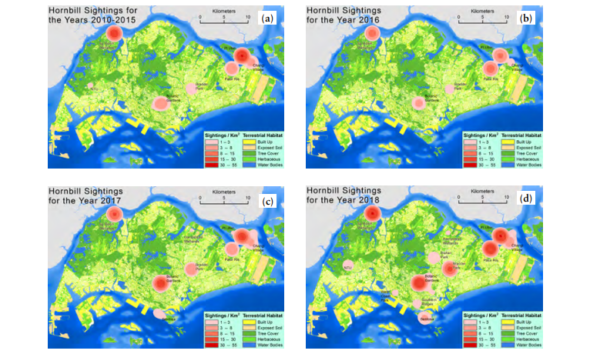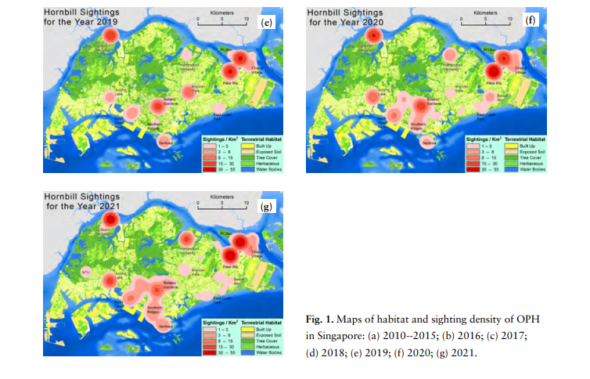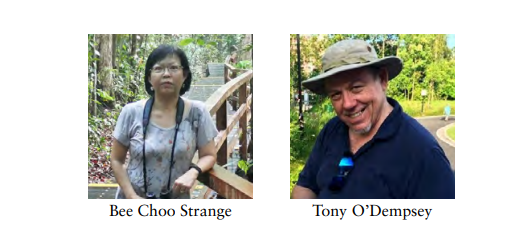This paper was published in Hornbill Natural History and Conservation vol. 3: 28-31, 2022
Bee Choo Strange1 * and Tony O’Dempsey2
1 Hornbill Research Foundation, Bangkok, Thailand & IUCN SSC Hornbill Specialist Group
2 Nature Society (Singapore)
*Corresponding author: Bee Choo Strange ([email protected])
Background
Three species of hornbill have been recorded in Singapore: Oriental Pied Hornbill Anthracoceros albirostris, Rhinoceros Hornbill Buceros bicornis (locally extinct), and Black Hornbill Anthracoceros malayanus (recent record). The Helmeted Hornbill Rhinoplax vigil historical record in Singapore is considered doubtful (Poonswad et al., 2013). Other species of hornbills recorded such as Bushy-crested, Great, Narcondam, Northern Red-billed, Trumpeter, Southern Ground, Wreathed and the White-crowned are considered escapees from captivity.
The Oriental Pied Hornbill (OPH) ranges from northern India, south Nepal, Bhutan, southeast Tibet to south China, and across Southeast Asia to Java and Bali. The OPH is a forest edge species occurring from coastal lowlands up to 700 m in elevation. This species is found in parks, plantations, wooded areas and near mangroves. Considered as medium size, the male is about 70–85 cm (700–900 g) and the female 60–65 cm (500–800 g) in length, with the male having a larger casque (Poonswad et al., 2013).
The renowned naturalist, Alfred R. Wallace, recorded this species in Singapore in 1855 and it was probably still in Singapore in the 1920s; however, there are no breeding records. Gibson-Hill mentioned that there was no record of hornbills in Singapore in the 1950s (GibsonHill, 1950). A small population recorded on the main island of Singapore in the late 1960s to late 1970s are presumed escapees. Some individuals were recorded in Pulau Ubin since 13 March 1994; they were believed to be visitors from Malaysia and the first local breeding was observed at Pulau Ubin on 26 April 1997 (Wang and Hails, 2007; Lim, 2009).
The breeding season of the OPH in Singapore generally starts from December and ends in March or April. Each clutch consists of one to four eggs, but usually only one to three chicks will fledge successfully (Teo, 2012). A paper (Ng et al., 2011) presented at the 5th International Hornbill Conference, held in Singapore from 22nd to 25th March 2009, documented camera surveys of five nests of wild Oriental Pied Hornbills in Pulau Ubin over four breeding seasons between 2005 and 2009, and one nest in the southern part of Bukit Timah Nature Reserve from 2008 to 2009 of a captive pair taken from Jurong Bird Park. The nests in Pulau Ubin were in natural cavities of Durio zibethinus trees and in artificial nest boxes, and 14 breeding cycles were recorded over four years. In the southern part of Bukit Timah Nature Reserve, two breeding were observed. Out of the 16 cycles, a total of 51 chicks hatched. The observations showed that the mean number of eggs laid in the wild was 3.3 and number of chicks fledged was 1.8 giving an average fledging success of 55%. Most of the chicks that were lost were due to cannibalism and infanticide.
In order to encourage wild hornbills to breed, more than 20 artificial nest boxes were installed all over Singapore from Pulau Ubin in the east to Sungei Buloh Wetland Reserve in the west (Cremades and Ng, 2012). The population has subsequently increased significantly throughout Singapore. In 2012, the population of OPH in Singapore was estimated to be between 75-100 individuals, with 19 nesting pairs recorded, of which 10 pairs were nesting in Pulau Ubin (east), two in Changi (east), two in the Istana (central), and one each in Turf City (central), Sungei Buloh (west), Seletar (north), MacRithchie (central), and Pasir Ris (east). The number of progeny in 2012 was estimated to be between 35 and 60 (Cremades and Ng, 2012).
Methods
In order to find out more about the current distribution of the OPH in Singapore, the first author downloaded eBird (https://ebird.org), iNaturalist (https://inaturalist.org) and other records from the Global Biodiversity Information Facility (GBIF) portal (GBIF.org 2022). There were 5177 occurrence records of OPH from Singapore in GBIF, of which 4533 are from eBird and 569 are research-grade observations on iNaturalist. As sightings prior to 2010 were considered to be very sparse, 4901 records ranging from 2010 to 2021 (including 4311 eBird and 518 iNaturalist records) were chosen for analysis. The sighting records were segregated into a selection of time periods and a kernel density filter was applied to each to create a series of sighting density maps that illustrate the dispersal of the Oriental Pied Hornbills from 2010 to 2021. Seven sighting density maps were generated for the periods 2010-2015 inclusive and one for each year from 2016 to 2021 (Figure 1).
Results and Discussion
The maps (Figures 1) show how the OPH has spread in Singapore over the past 12 years and that the dispersal of the hornbills are in areas near the reintroduction sites, with more sightings in the eastern part of Singapore. A pair of captive OPH from Jurong Bird Park was chosen to be bred in an artificial nest box in the southern part of Bukit Timah Nature Reserve for two breeding cycles in 2009, resulting in three chicks fledging (Cremades et al., 2011). It is of particular interest to note that subsequent sighting records from 2010 to 2021 did not show any OPH in the forests, and no hornbills were reported in the Central Catchment Nature Reserve and Bukit Timah Nature Reserve. Poonswad et al. (2013) indicated that the preferred habitats of this species are forest edges, open woodlands, coastal and riverine scrub and cultivation. We can speculate that this species may disperse further in the future, if their survival and dispersal in Singapore is encouraged by planting of food plants in various parks and gardens. We note, however, that the increased dispersal of OPH denoted on the maps may be partly due to increased reporting and records by observers on eBird and iNaturalist in recent years, and this needs to be studied and corrected for observer effort in different areas in future studies. To find out more about the dispersal and estimate the current population of the OPH in Singapore, a citizen science project was started in February 2022 in collaboration with Nature Society (Singapore), for which a part-time researcher was hired. Dr. Yong Ding Li of the Nature Society (Singapore), Dr. Rohit Naniwadekar of the Nature Conservation Foundation (India), and Assoc. Prof. Dr. George Gale of the King Mongkut’s University of Technology Thonburi (Thailand) provided advice about survey methodology and information to collect. The survey is underway and will help better understand hornbill distribution and abundance in Singapore.


Acknowledgements
We would like to thank Dr. Yong Ding Li, Dr. Rohit Naniwadekar and Assoc. Prof. Dr. George Gale for their invaluable advice. Mr. Evan Landy has been very helpful in setting up the transect survey grids and communicating with over 90 volunteers and assigning them their transects. Thanks also to Mr. Morten Strange, Dr. Shawn Lum, Dr. Jessica Lee and Mr. Lim Kim Chuah of the NSS bird group who have helped with this project. The base habitat map is derived from A High Resolution Map of Singapore’s Terrestrial Ecosystems (Gaw LY-F, Yee ATK, Richards DR, 2019). This project is funded by the Nature Society (Singapore).
References
Cremades M, Lai HM, et al. 2011. Re-introduction of the Oriental Pied Hornbill in Singapore, with emphasis on artificial nest. The Raffles Bulletin of Zoology Supplement 24: 5–10.
Cremades M and Ng SC. 2012. Hornbills in the City: A Conservation Approach to Hornbill Study in Singapore. National Parks Board, Singapore. Gaw LY-F, Yee ATK, Richards DR. 2019. A high-resolution map of Singapore’s terrestrial ecosystems. Data 4(3): 116. https:// doi.org/10.3390/data4030116
GBIF.org. 2022. Oriental Pied Hornbill GBIF records. Downloaded on 16 May 2022 https:// www.gbif.org/occurrence/search?taxon_ key=2475991&gadm_gid=SGP
Gibson-Hill CA. 1950. Ornithological notes from Raffles Museum, No. 14, Annotations, Addenda & Corrigenda to the Singapore Checklist. Bulletin of the Raffles Museum 23: 132–183.
Lim KS. 2009. The Avifauna of Singapore, Nature Society, Singapore.
Ng SC, Lai HM, et al. 2011. Breeding observations on the Oriental Pied Hornbills in nest cavities and in artificial nests in Singapore, with emphasis on infanticide-cannibalism. The Raffles Bulletin of Zoology Supplement No. 24: 15–22.
Poonswad P, Kemp A and Strange M. 2013. Hornbills of the World: A Photographic Guide. Draco Publishing.
Teo R. 2012. Special Ecology Feature: Conserving Hornbills in the Urban Environment. A Centre for Urban Greenery and Ecology Publication City Green #4, 130–135.
Wang LK and Hails CJ. 2007. An Annotated Checklist of the Birds of Singapore. The Raffles Bulletin of Zoology Supplement No. 15.

Note to readers: If you like this post please tap on the Like button at the left bottom of page.








